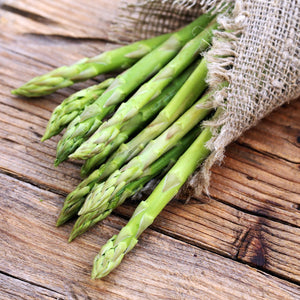- Home
- Planting Guides
- Asparagus Planting & Growing Guide
Asparagus Planting & Growing Guide
Asparagus is one of those gifts that just keeps giving. Plant this perennial vegetable one early spring and, with a little patience, you’ll be harvesting tender, delicious spears for years—as much as 20 years for some varieties! Whether you eat them fresh, canned, or frozen, Asparagus is a worthwhile investment in your edible garden. Read on to learn how to plant, grow, and care for Asparagus with our comprehensive guide.
Success Snapshot
PLANTING
DEPTH
4-5 inches

WATER
QUANTITY
Moderate
SUNLIGHT
QUANTITY
Full Sun
PLANTING
PROXIMITY
6-8 inches
BLOOM
SEASON
Harvest at 7-9 inches
HARDINESS
ZONES
Zones 4-8
Shop Related Products

Asparagus - Purple Passion
$14.95
Contains: 10 asparagus crowns
Botanical Name: Asparagus officinalis 'Purple Passion'
Exposure: Full Sun
Hardiness: Zones 4-8

Asparagus - Harvest Collection
$41.95
Contains: 30 Asparagus crowns - 10 of each variety
Botanical Name: Asparagus officinalis
Exposure: Full Sun
Hardiness: Zones 4-8

Asparagus - Jersey Supreme
$19.95
Contains: 10 asparagus crowns
Botanical Name: Asparagus officinalis 'Jersey Supreme'
Exposure: Full Sun
Hardiness: Zones 4-8

Asparagus - Millennium
$14.95
Contains: 10 asparagus crowns
Botanical Name: Asparagus officinalis 'Millennium'
Exposure: Full Sun
Hardiness: Zones 4-8
Where to Plant Asparagus
Plant Asparagus in full sun in well-draining soil in zones 3–8. Asparagus can tolerate some shade but without enough sun, the spears will be spindly.
When to Plant Asparagus
Plant Asparagus in early spring as soon as danger of frost has passed and the soil is workable.
How to Plant Asparagus
- Find a location with full sun and well-draining soil. If you notice that water still puddles 5 to 6 hours after a hard rain, it's best to find a different spot or plant in a raised bed or container.
- Plant your Asparagus crowns as soon as possible after they arrive. Before planting, rinse the crowns just to rehydrate them a little.
- Dig a trench 8–10 inches deep. Mound loose soil mixed with compost or composted manure at the bottom of the trench and water it well.
- Lay the crowns 1 foot apart with the tops 6–8 inches below ground level and spread the roots out over the soil mound. Cover with 2 inches more of the soil and compost mixture and water again.
How to Grow Asparagus
- Fill in more soil and compost a few inches at a time as the plants grow. Be sure not to cover the tips of the plants. Asparagus plants will grow to 4 feet high with feathery green foliage.
- Water at least once a week, more often in warm weather; 1” of water at a time is a good estimate. Stick a finger into the soil around the roots to make sure the water is permeating to where the roots can access it without drowning them. Too much water can cause the crowns to rot.
- Add a light mulch to the surrounding soil to improve drainage, reduce evaporation, and keep competing weeds at bay.
Asparagus Tips & Tricks
- Skip taking any harvest the first year in order to let the Asparagus plants to establish a good root system.
- Harvest in the second year by cutting the spears at soil level at a 45-degree angle. After 4–6 weeks of harvest, just let the plants grow without any more cutting.
- Harvest for 8–10 weeks in the third year.
- Apply additional compost around the plants after each harvest and water deeply.
- Keep the area well weeded so the plants won’t need to compete for water and nutrients.
- In late fall/early winter cut the Asparagus stems to the ground and clear the area of debris to prevent insect predators from overwintering. In areas with significant snowfall, you can leave stems up until spring to catch some of the snow and keep it off the crowns.




